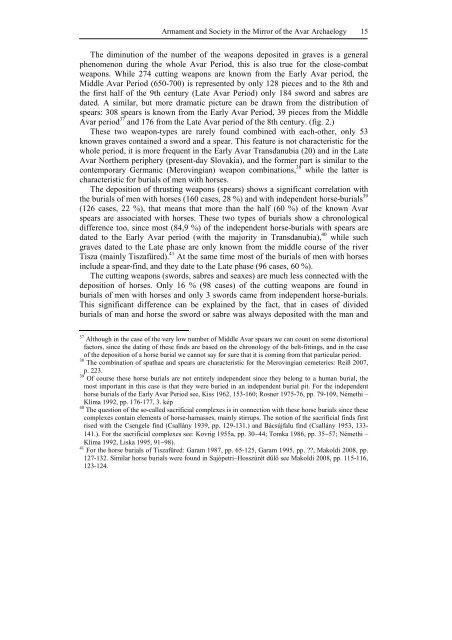Download - Facultatea de Științe Socio-Umane - Universitatea ...
Download - Facultatea de Științe Socio-Umane - Universitatea ...
Download - Facultatea de Științe Socio-Umane - Universitatea ...
You also want an ePaper? Increase the reach of your titles
YUMPU automatically turns print PDFs into web optimized ePapers that Google loves.
Armament and Society in the Mirror of the Avar Archaelogy<br />
The diminution of the number of the weapons <strong>de</strong>posited in graves is a general<br />
phenomenon during the whole Avar Period, this is also true for the close-combat<br />
weapons. While 274 cutting weapons are known from the Early Avar period, the<br />
Middle Avar Period (650-700) is represented by only 128 pieces and to the 8th and<br />
the first half of the 9th century (Late Avar Period) only 184 sword and sabres are<br />
dated. A similar, but more dramatic picture can be drawn from the distribution of<br />
spears: 308 spears is known from the Early Avar Period, 39 pieces from the Middle<br />
Avar period 37 and 176 from the Late Avar period of the 8th century. (fig. 2.)<br />
These two weapon-types are rarely found combined with each-other, only 53<br />
known graves contained a sword and a spear. This feature is not characteristic for the<br />
whole period, it is more frequent in the Early Avar Transdanubia (20) and in the Late<br />
Avar Northern periphery (present-day Slovakia), and the former part is similar to the<br />
contemporary Germanic (Merovingian) weapon combinations, 38 while the latter is<br />
characteristic for burials of men with horses.<br />
The <strong>de</strong>position of thrusting weapons (spears) shows a significant correlation with<br />
the burials of men with horses (160 cases, 28 %) and with in<strong>de</strong>pen<strong>de</strong>nt horse-burials 39<br />
(126 cases, 22 %), that means that more than the half (60 %) of the known Avar<br />
spears are associated with horses. These two types of burials show a chronological<br />
difference too, since most (84,9 %) of the in<strong>de</strong>pen<strong>de</strong>nt horse-burials with spears are<br />
dated to the Early Avar period (with the majority in Transdanubia), 40 while such<br />
graves dated to the Late phase are only known from the middle course of the river<br />
Tisza (mainly Tiszafüred). 41 At the same time most of the burials of men with horses<br />
inclu<strong>de</strong> a spear-find, and they date to the Late phase (96 cases, 60 %).<br />
The cutting weapons (swords, sabres and seaxes) are much less connected with the<br />
<strong>de</strong>position of horses. Only 16 % (98 cases) of the cutting weapons are found in<br />
burials of men with horses and only 3 swords came from in<strong>de</strong>pen<strong>de</strong>nt horse-burials.<br />
This significant difference can be explained by the fact, that in cases of divi<strong>de</strong>d<br />
burials of man and horse the sword or sabre was always <strong>de</strong>posited with the man and<br />
37<br />
Although in the case of the very low number of Middle Avar spears we can count on some distortional<br />
factors, since the dating of these finds are based on the chronology of the belt-fittings, and in the case<br />
of the <strong>de</strong>position of a horse burial we cannot say for sure that it is coming from that particular period.<br />
38<br />
The combination of spathae and spears are characteristic for the Merovingian cemeteries: Reiß 2007,<br />
p. 223.<br />
39<br />
Of course these horse burials are not entirely in<strong>de</strong>pen<strong>de</strong>nt since they belong to a human burial, the<br />
most important in this case is that they were buried in an in<strong>de</strong>pen<strong>de</strong>nt burial pit. For the in<strong>de</strong>pen<strong>de</strong>nt<br />
horse burials of the Early Avar Period see, Kiss 1962, 153-160; Rosner 1975-76, pp. 79-109, Némethi –<br />
Klíma 1992, pp. 176-177, 3. kép<br />
40<br />
The question of the so-called sacrificial complexes is in connection with these horse burials since these<br />
complexes contain elements of horse-harnasses, mainly stirrups. The notion of the sacrificial finds first<br />
rised with the Csengele find (Csallány 1939, pp. 129-131.) and Bácsújfalu find (Csallány 1953, 133-<br />
141.). For the sacrificial complexes see: Kovrig 1955a, pp. 30−44; Tomka 1986, pp. 35−57; Némethi –<br />
Klíma 1992, Liska 1995, 91−98).<br />
41<br />
For the horse burials of Tiszafüred: Garam 1987, pp. 65-125, Garam 1995, pp. ??, Makoldi 2008, pp.<br />
127-132. Similar horse burials were found in Sajópetri–Hosszúrét dűlő see Makoldi 2008, pp. 115-116,<br />
123-124.<br />
15





